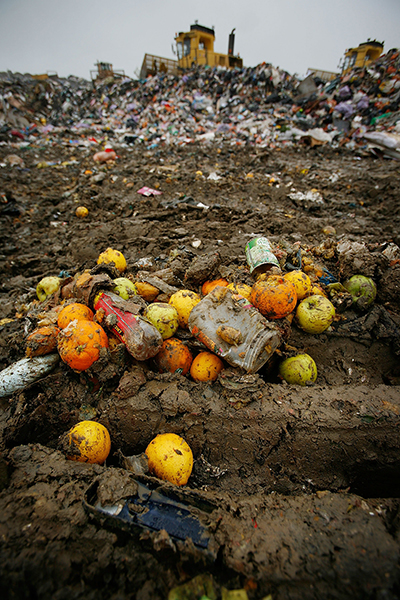It’s a staggering problem whose true proportions only recently became apparent.
Some 80 billion pounds of food is discarded in U.S. landfills each year, with a huge cost to the environment, economy and people’s lives.

Now the food industry — including food retailers, manufacturers and foodservice operators — is at a pivotal point in facing this challenge. It’s armed with more accurate measurements and ambitious waste-reduction goals, and is striving to build on existing achievements as quickly as possible, according to speakers and participants at the inaugural Food Recovery Forum held at the annual Waste Expo event in Las Vegas this week.
“Over the past year and a half there’s been a big uptick in interest in the food waste challenge,” said Meghan Stasz, senior director, Sustainability, Grocery Manufacturers Association, who is that association’s lead in the cross-industry Food Waste Reduction Alliance (FWRA). “We’ve done a good job establishing where food waste comes from by segment and the major barriers. Now we need to pivot to what are the solutions we can use together to overcome the barriers.”
One of the recent landmark moments came last September when the USDA and EPA established the goal of reducing U.S. food waste 50% by 2030.
“That’s an exciting, audacious goal,” said Hunt Briggs, consultant and organics lead, Resource Recycling Systems. He noted that the goal aligns with a similar one from the United Nations. However, it will take a lot of effort in areas including policy, financial, consumer education and innovative solutions, he added.

Waste Expo is produced by Waste 360 in collaboration with the National Waste and Recycling Association. The event is owned by Penton, a media and information services company that is the parent company of SN.
The U.S. industry’s efforts to keep food out of landfills coincides with global initiatives, given predictions there will be some 2 billion more people to feed worldwide by 2050.
U.S. initiatives to attack the problem include cutting the amount of surplus food generated, feeding hungry people through donations, pursuing industrial uses for waste, and recycling efforts such as composing and anaerobic digestion, which converts organic materials to recover energy.
Waste reduction
Retailers cited for successes in dealing with food waste include Walmart, Kroger and Wegmans Food Markets. The benefits include helping the environment, boosting efficiency and gaining creditability with consumers and employees.
“I tell Wegmans colleagues that reducing food waste is a way our employees can make a difference,” said Jason Wadsworth, Wegmans’ sustainability manager. "You need to start somewhere, and then when you see an impact, you do more.”

Wegmans’ programs include repurposing foods for other uses, donating food, and pursuing recycling that includes composting and anaerobic digestion, which now involves 69 of 89 Wegmans stores, he said.
“There are also packaging opportunities for reducing food waste,” he added. “We use a lot of vacuum-sealed meats, which can increase shelf life and help with portioning.”
Details of food waste are different by industry sector because of vastly different operating environments. Restaurants account for some 37% of food waste, compared with 2% for retailers and 3% for manufacturers, according to data from FWRA. The biggest portion is from consumers and residential waste.
More than 40% of wasted food from grocery stores is donated or recycled, according to the data. However, donations involve special hurdles for retailers. Some 67% of retailers and wholesalers surveyed cited liability concerns as the biggest challenge, according to FWRA. That compares with 50% pointing to insufficient storage and refrigeration at food banks, 42% mentioning transportation constraints, 33% insufficient on-site storage and refrigeration, and 17% regulatory constraints.
Donation efforts should include agreements between organizations specifying types and quantities of foods, pickup frequency, how food will be handled, and shared certifications and documentations, said Lorenzo Macaluso, director of Green Business Services at the Center for EcoTechnology.
Food rescues
Not lost on anyone is the enormous need for donations. Nearly 50 million in the U.S. lack the funds to secure adequate nutrition, according to the U.S. Department of Agriculture.
Feeding America, a national hunger and food rescue organization, with more than 200 food banks and 61,000 emergency shelters, food pantries and soup kitchens, pursues partnerships with companies for donations.

“Let’s not talk waste, let’s talk unused nutrients that can be used to feed people,” said Karen Hanner, managing director of Manufacturing Partnerships for Feeding America.
Hanner pointed to a wide range of innovative food rescue donation programs, including from ConAgra Foods, DelMonte, Nestle, General Mills and Starbucks.
At Nestle USA, Michael Desso, director, Safety, Health and Environment, said the organization has a global commitment to reduce food loss and waste.
“This includes focusing on responsible sourcing, including requirements that suppliers are producing efficiently with strong environmental programs,” he said.
Foodservice operators face a number of barriers in combating waste, but “the No. 1 issue is overproduction, because of fear of running out of food,” said Todd Pendexter, business development manager, LeanPath, which helps foodservice operators minimize waste.
“If you’re a foodservice operator, making thousands of meals a day, food waste is part of doing business, so you need to put a program in place to help prevent it,” he added.
Waste prevention is reduced by measurement and setting smart goals, he explained. Solutions he recommended include adjusting production, purchasing differently, changing packaging and making adjustments according to demographics and days of the week.
Collaboration
Many in the food industry say the best way to tackle waste is through collaborative programs involving companies, associations and other organizations.
ReFED is a nonprofit collaboration of more than 30 business, nonprofit, foundation and government leaders focused on reducing U.S. food waste. The group recently released an action plan called “A Roadmap to Reduce U.S. Food Waste by 20 Percent.”

Collaboration between associations and their members was responsible for the formation of FWRA in 2011 by GMA, Food Marketing Institute, and National Restaurant Association. It’s goals are to help reduce the amount of wasted food, increase donations of safe, nutritious food, and recycle other food waste to avoid having it enter landfills, according to the group’s best practices and solutions guide.
The group provides research, toolkits and other resources and guidance.
​Stasz of FWRA said the industry can point to notable achievements despite ongoing hurdles. “One of those achievements is getting more entities to measure food waste, because the ROI is tremendous and that’s how you find ways to improve and make changes to longstanding practices.”
However, she added, measurement is difficult to do, especially for big companies.
Other achievements include finding new solutions to the waste problem and sharing best practices, which will be a big focus going forward.
“We need to share best practices more broadly so not every company has to reinvent the wheel,” she said.
| Suggested Categories | More from Supermarket News |
 |
|
 |
|





